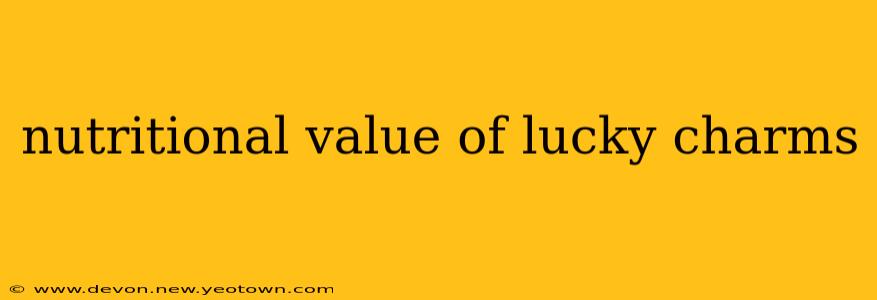For many, the brightly colored marshmallows and oat-based cereal pieces of Lucky Charms evoke a sense of childhood nostalgia. But beyond the whimsical charms and sugary sweetness, lies a question many parents and health-conscious individuals ask: What's the real nutritional value of Lucky Charms? Let's unravel the sugary mystery and delve into the facts.
This isn't just another cursory glance at the nutrition label; we'll explore the ingredients, dissect the macro and micronutrients, and address common concerns surrounding this beloved breakfast cereal. We'll even tackle some frequently asked questions to paint a complete picture of Lucky Charms' nutritional profile.
What are the main ingredients in Lucky Charms?
Lucky Charms' primary ingredients are whole grain oats, sugar, corn syrup, and a medley of marshmallows boasting artificial colors and flavors. The oat-based pieces provide some nutritional value, particularly fiber, but the significant addition of sugar and processed ingredients significantly alters the overall nutritional landscape. This blend creates a cereal that's undeniably delicious but less so when scrutinized for nutritional merit. Understanding the ingredients list is crucial to grasping its nutritional impact.
How much sugar is in a serving of Lucky Charms?
This is a key question for many parents. A single serving of Lucky Charms (typically about ¾ of a cup) packs a considerable amount of sugar—around 10 grams, or roughly 25% of the recommended daily intake of added sugar for adults. For children, this percentage is even higher. This high sugar content contributes to the cereal's delicious taste but is a primary concern regarding its overall health implications. Excessive sugar intake is linked to various health issues, including weight gain, dental problems, and an increased risk of chronic diseases.
Are there any vitamins or minerals in Lucky Charms?
While Lucky Charms aren't a nutritional powerhouse, they do offer some vitamins and minerals, primarily through fortification. The cereal is often enriched with iron and some B vitamins. However, the quantities are often modest compared to the high sugar content. It's important to remember that these added vitamins and minerals don't offset the negative impact of the high sugar and low fiber content.
Is Lucky Charms a healthy breakfast cereal?
The short answer is no, Lucky Charms isn't considered a healthy breakfast choice for regular consumption. The high sugar content far outweighs the benefits of the limited vitamins and minerals. A better approach would be to choose cereals with lower sugar content, higher fiber, and a more balanced nutritional profile. While an occasional bowl won't cause significant harm, relying on Lucky Charms as a daily breakfast can negatively impact overall health and well-being.
How does Lucky Charms compare to other breakfast cereals?
When compared to other breakfast cereals, Lucky Charms stands out due to its exceptionally high sugar content. Many healthier alternatives offer a comparable taste and satisfying texture while boasting significantly less sugar, more fiber, and a richer array of vitamins and minerals. Reading nutrition labels and comparing ingredient lists is vital when choosing a cereal that aligns with your health goals.
Can I eat Lucky Charms as part of a balanced diet?
Moderation is key. Occasional consumption of Lucky Charms as part of a balanced and varied diet is unlikely to cause significant harm. However, making it a regular part of your diet is not advisable due to its high sugar content. A balanced diet should prioritize whole grains, fruits, vegetables, lean proteins, and healthy fats, minimizing processed foods and sugary snacks.
In conclusion, while Lucky Charms holds a special place in many hearts (and pantries!), a clear-eyed examination of its nutritional value reveals a cereal that should be enjoyed sparingly. Prioritizing healthier breakfast options rich in fiber, vitamins, and minerals is crucial for maintaining a balanced and nutritious diet. Let the magic of Lucky Charms remain a delightful, occasional treat, not a daily dietary staple.

